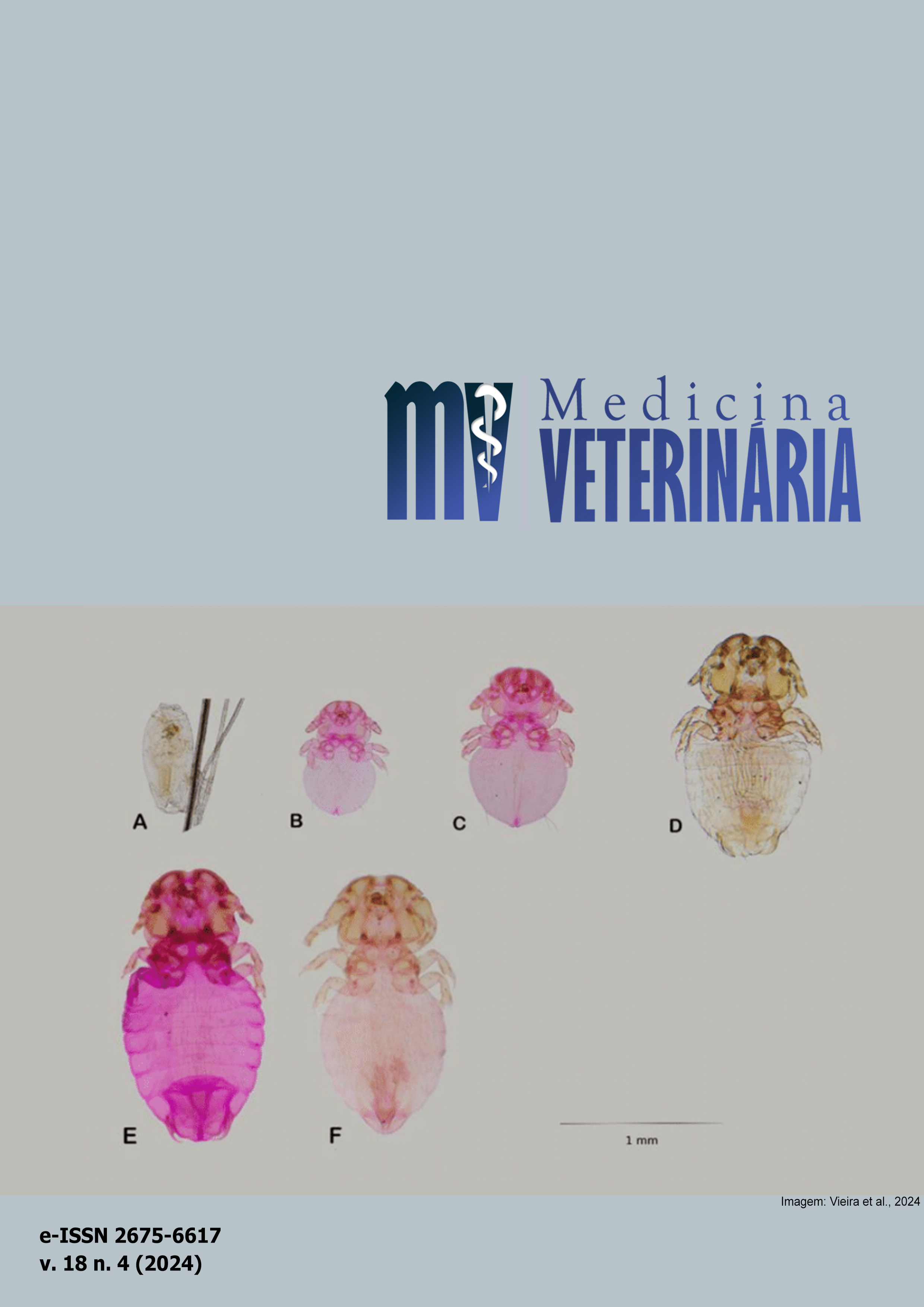Considerations about traumatic diaphragmatic hernia in small animals
DOI:
https://doi.org/10.26605/medvet-v18n4-6638Palabras clave:
diaphragm rupture, dogs, cats, surgeryResumen
Diaphragmatic hernia is a relatively common disorder in routine surgical procedures for small animals. This hernia is characterized by discontinuity of the diaphragm due to a rupture or defect, which may result in the displacement of abdominal organs into the thoracic cavity. Therefore, this review aims to provide information about the anatomy of the diaphragm and associated structures, as well as the causes, clinical signs, diagnosis, and treatment options for acquired diaphragmatic hernia. The diaphragm is an inspiratory muscle composed of a muscle portion that surrounds a central tendon. Traumatic diaphragmatic hernia is commonly associated with motor vehicle accidents. The diagnosis is based on clinical history and physical examination, but the final definition requires imaging studies, in which plain radiographic examination is the most frequently used. However, an ultrasound examination is necessary in some cases. Treatment involves surgical correction of the rupture, usually performed through a median celiotomy.Descargas
Citas
Baines, S. Surgery of the diaphragm. In: Brockman, D.J.; Holt, D.E.; Haar, G.T. BSAVA manual of canine and feline head, neck and thoracic surgery. Gloucester: BSAVA, 2018. p.209-227.
Bellah, J.R. Traumatic diaphragmatic hernia. In: Bojrab, M.J.; Waldron, D.; Toombs, J.P. Current techniques in small animal surgery. Jackson: Tenton NewMedia, 2014. p.352-361.
Clair, L.E. Músculos do carnívoro. In: Getty, R. Sisson Grossman anatomia dos animais domésticos. Rio de Janeiro: Guanabara Koogan, 1986. p.1416-1441.
Deveci, M.Z.Y.; Yurtal, Z.; ??ler C.T.; Emiro?lu, S.B.; Alaku?, I.; Altu?, M.E. Herniorrhaphy and surgical outcomes of diaphragmatic hernia in cats. Slovenian Veterinary Research, 59(1): 47-57, 2022.
Fossum, T.W. Surgery of the lower respiratory system: pleural cavity and diaphragm. In: Fossum, T.W. Small Animal Surgery. Philadelphia: Elsevier, 2019. p.916-955.
Garson, H.L.; Dodman, N.H.; Baker, G.J. Diaphragmatic hernia. Analysis of fifty-six cases in dogs and cats. Journal of Small Animal Practice, 21(9): 469–481, 1980.
Gibson, T.W.G.; Brisson, B.A.; Sears, W. Perioperative survival rates after surgery for diaphragmatic hernia in dogs and cats. Journal of the American Veterinary Medical Association, 227(1): 105-109, 2005.
Hunt, G.B.; Johnson, K.A. Diaphragmatic hernias. In: Johnston, S.A.; Tobias, K.M.; Peck, J.N.; Kent, M. Veterinary surgery small animal. Saint Louis: Elsevier, 2018. p.4306- 4337.
Hunt, G.H. Diaphragmatic hernia. In: Bojrab M.J.; Monnet, E. Mechanisms of disease in small animal surgery. Jackson: Teton NewMedia, 2010. p.445-457.
Hyun, C. Radiographic diagnosis of diaphragmatic hernia: review of 60 cases in dogs and cats. Journal of Veterinary Science, 5(2): 157-162, 2004.
Kagan, K.G. Thoracic trauma. Veterinary Clinics of North America: Small Animal Practice, 10(3): 641-653, 1980.
Larson, M.M. Diseases of the mediastinum, chest wall, and diaphragm. In: Côté, E.; Ettinger, S.J.; Feldman, E.C. Ettinger’s textbook of veterinary internal medicine. Philadelphia: Elsevier, 2024. p.3557-3581.
Levine, S.H. Diaphragmatic hernia. Veterinary Clinics of North America: Small Animal Practice, 17(2): 411-430, 1987.
Liebich, H.G.; Maierl, J.; König, H.E. Fasciae and muscles of head, neck and trunk. In: König, H.E.; Liebich, H.G. Veterinary anatomy of domestic animals. Stuttgart: Thieme, 2020. p.137-169.
McClaran, J.K. Diaphragmatic and peritoneopericardial diaphragmatic hernias. In: Monnet, E. Small animal soft tissue surgery. Ames: John Wiley & Sons, 2013. p.278-285.
Pereira, G.J.; Rahal, S.C.; Melchert, A.; Abibe, R.B.; Brandão, C.V.S.; Quitzan, J.G.; Mesquita, L.R.; Mamprim, M.J. Eleven-year retrospective analysis of acquired diaphragmatic hernia in 49 dogs and 48 cats. The Canadian Veterinary Journal, 64(2): 149–152, 2023.
Raiser, A.G. Herniorrafia diafragmática em cães e gatos. Relato de 22 casos e proposição de técnica para corrigir rupturas freno-costais. Brazilian Journal of Veterinary Research Animal Science, 31(3/4): 245-251, 1994.
Sullivan, M.; Reid, J. Management of 60 cases of diaphragmatic rupture. Journal of Small Animal Practice, 31(9): 425-430, 1990.
Worth, A.J., Machon R.G. Traumatic diaphragmatic herniation: pathophysiology and management. Compendium on Continuing Education for the Practising Veterinarian, 27(3): 178-191, 2005.
Worth, A.J.; Machon, R.G. Prevention of reexpansion pulmonary edema and ischemia–reperfusion injury in the management of diaphragmatic herniation. Compendium on Continuing Education for the Practising Veterinarian, 28(3): 531–540, 2006.
Descargas
Publicado
Cómo citar
Número
Sección
Licencia
Derechos de autor 2024 Raíne da Luz de Toledo, Sheila Canevese Rahal, Fátima Maria Caetano Caldeira, Luciane dos Reis Mesquita, Maria Jaqueline Mamprim, Geovane José Pereira, Cláudia Valéria Seullner Brandão, Jeana Pereira da Silva, Ricardo Shoiti Ichikawa

Esta obra está bajo una licencia internacional Creative Commons Atribución-NoComercial-CompartirIgual 4.0.
- A Revista de Medicina Veterinária permite que o autor retenha os direitos de publicação sem restrições, utilizando para tal a licença Creative Commons CC BY-NC-SA 4.0.
- De acordo com os termos seguintes:
- Atribuição — Você deve dar o crédito apropriado, prover um link para a licença e indicar se mudanças foram feitas. Você deve fazê-lo em qualquer circunstância razoável, mas de nenhuma maneira que sugira que o licenciante apoia você ou o seu uso.
- NãoComercial — Você não pode usar o material para fins comerciais.
- CompartilhaIgual — Se você remixar, transformar, ou criar a partir do material, tem de distribuir as suas contribuições sob a mesma licença que o original.
- Sem restrições adicionais — Você não pode aplicar termos jurídicos ou medidas de caráter tecnológico que restrinjam legalmente outros de fazerem algo que a licença permita.










